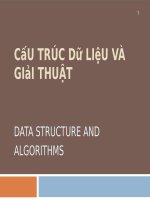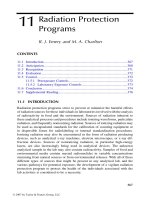Data Structure and Algorithms CO2003 Chapter 11 Graph
Bạn đang xem bản rút gọn của tài liệu. Xem và tải ngay bản đầy đủ của tài liệu tại đây (1.59 MB, 83 trang )
Chapter 11 - Graph
•A
Graph G consists of a set V, whose members are called the
vertices of G, together with a set E of pairs of distinct vertices
from V.
•
The pairs in E are called the edges of G.
•
If the pairs are unordered, G is called an undirected graph or a
graph. Otherwise, G is called a directed graph or a digraph.
•
Two vertices in an undirected graph are called adjacent if there
is an edge from the first to the second.
Chapter 11 - Graph
•A
path is a sequence of distinct vertices, each adjacent to the
next.
•A
cycle is a path containing at least three vertices such that the
last vertex on the path is adjacent to the first.
•A
graph is called connected if there is a path from any vertex to
any other vertex.
•A
free tree is defined as a connected undirected graph with no
cycles.
Examples of Graph
Digraph as an adjacency table
Directed graph
Adjacency set
Adjacency table
Digraph
count <integer>
// Number of vertices
edge
Weighted-graph as an adjacency table
Weighted-graph
vertex vector
WeightedGraph
count <integer>
edge
adjacency table
// Number of vertices
// Adjacency table
Weighted-graph as an adjacency list
Digraph as an adjacency list
Directed graph
contiguous structure
linked structure
mixed structure
Digraph as an adjacency list (not using List ADT)
V
Directed graph
first_vertex
DiGraph
first_vertex
End DiGraph
linked structure
Digraph as an adjacency list (using List ADT)
head
digraph
0
head
1
2
1
head
2
3
2
head
3
head
0
1
GraphNode
vertex <VertexType> // (key field)
adjVertex
are hidden
outdegree <int>
isMarked <boolean>
End GraphNode
from the
image below
2
GraphNode
ADT List is linked list:
DiGraph
digraph
vertex adjVertex
2
head
Digraph as an adjacency list (using List ADT)
mixed list
GraphNode
vertex <VertexType> // (key field)
adjVertex
outdegree <int>
isMarked <boolean>
End GraphNode
ADT List is contiguous list:
DiGraph
digraph
End DiGraph
Digraph as an adjacency list (using List ADT)
contiguous list
GraphNode
vertex <VertexType> // (key field)
adjVertex
outdegree <int>
isMarked <boolean>
End GraphNode
ADT List is contiguous list:
DiGraph
digraph
GraphNode
<void> GraphNode() // constructor of GraphNode
1. indegree = 0
2. outdegree = 0
3. adjVertex.clear() // By default, constructor of adjVertex
made it empty.
End GraphNode
GraphNode
vertex adjVertex
head
Operations for Digraph
Insert
Vertex
Delete Vertex
Insert edge
Delete edge
Traverse
Digraph
Digraph
private:
digraph
public:
<ErrorCode> InsertVertex (val newVertex <VertexType>)
<ErrorCode> DeleteVertex (val Vertex <VertexType>)
<ErrorCode> InsertEdge (val VertexFrom <VertexType>,
val VertexTo <VertexType>)
<ErrorCode> DeleteEdge (val VertexFrom <VertexType>,
val VertexTo <VertexType>)
// Other methods for Graph Traversal.
End Digraph
Methods of List ADT
Methods of Digraph will use these methods of List ADT:
<ErrorCode> Insert (val DataIn <DataType>)
// (success, overflow)
<ErrorCode> Search (ref DataOut <DataType>) // (found, notFound)
<ErrorCode> Remove (ref DataOut <DataType>) // (success , notFound)
<ErrorCode> Retrieve (ref DataOut <DataType>) // (success , notFound)
<ErrorCode> Retrieve (ref DataOut <DataType>, position <int>)
// (success , range_error)
<ErrorCode> Replace (val DataIn <DataType>, position <int>)
// (success, range_error)
<ErrorCode> Replace (val DataIn <DataType>, val DataOut <DataType>)
// (success, notFound)
<boolean> isFull()
<boolean> isEmpty()
<integer> Size()
Insert New Vertex into Digraph
<ErrorCode> InsertVertex (val newVertex <VertexType>)
Inserts new vertex into digraph.
Insert New Vertex into Digraph
<ErrorCode> InsertVertex (val newVertex <VertexType>)
1. DataOut.vertex = newVertex
2. if (digraph.Search(DataOut) = success)
1. return duplicate_error
3. else
1. return digraph.Insert(DataOut) // success or overflow
End InsertVertex
GraphNode
vertex <VertexType> // (key field)
adjVertex
outdegree <int>
isMarked <boolean>
End GraphNode
Delete Vertex from Digraph
<ErrorCode> DeleteVertex (val Vertex <VertexType>)
Deletes an existing vertex.
Delete Vertex from Digraph
<ErrorCode> DeleteVertex (val Vertex <VertexType>)
1. DataOut.vertex = Vertex
2. if (digraph.Retrieve(DataOut) = success)
1. if (DataOut.indegree>0)
1. digraph.Remove_EdgeToVertex(Vertex)
2. digraph.Remove(DataOut)
3. return success
3. else
1. return notFound
GraphNode
End DeleteVertex
vertex <VertexType> // (key field)
adjVertex
outdegree <int>
isMarked <boolean>
End GraphNode
Auxiliary function Remove all Edges to a Vertex
<void> Remove_EdgesToVertex(val VertexTo <VertexType>)
Removes all edges from any vertex to VertexTo if exist.
1. position = 0
2. loop (digraph.Retrieve(DataFrom, position) = success)
1. if (DataFrom.outdegree>0)
1. if (DataFrom.adjVertex.Remove(VertexTo) = success)
1. DataFrom.outdegree = DataFrom.outdegree - 1
2. digraph.Replace(DataFrom, position)
2. position = position + 1
GraphNode
End Remove_EdgesToVertex
vertex <VertexType> // (key field)
adjVertex
outdegree <int>
isMarked <boolean>
End GraphNode
Insert new Edge into Digraph
<ErrorCode> InsertEdge (val VertexFrom<VertexType>,
val VertexTo <VertexType>)
Inserts new edge into digraph.
1. DataFrom.vertex = VertexFrom
2. DataTo.vertex = VertexTo
3. if ( digraph.Retrieve(DataFrom) = success )
1. if ( digraph.Retrieve(DataTo) = success )
1. newData = DataFrom
2. if ( newData.adjVertex.Search(VertexTo) = found )
1. return duplicate_error
3. if ( newData.adjVertex.Insert(VertexTo) = success )
1. newData.outdegree = newData.outdegree +1
2. digraph.Replace(newData, DataFrom)
3. return success
GraphNode
4. else
vertex <VertexType> // (key field)
1. return overflow
adjVertex
indegree <int>
1. return notFound_VertexTo
outdegree <int>
4. else
isMarked <boolean>
1. return notFound_VertexFrom
End GraphNode
End InsertEdge
Delete Edge from Digraph
<ErrorCode> DeleteEdge (val VertexFrom <VertexType>,
val VertexTo <VertexType>)
Deletes an existing edge in the digraph.
1. DataFrom.vertex = VertexFrom
2. DataTo.vertex = VertexTo
3. if ( digraph.Retrieve(DataFrom) = success )
1. if ( digraph.Retrieve(DataTo) = success )
1. newData = DataFrom
2. if ( newData.adjVertex.Remove(VertexTo) = success )
1. newData.outdegree = newData.outdegree -1
2. digraph.Replace(newData, DataFrom)
3. return success
3. else
1. return notFound_Edge
GraphNode
2. else
vertex <VertexType> // (key field)
1. return notFound_VertexTo
adjVertex
indegree <int>
1. return notFound_VertexFrom
outdegree <int>
End DeleteEdge
isMarked <boolean>
End GraphNode
Graph Traversal
Depth-first traversal: analogous to preorder traversal of an
oredered tree.
Breadth-first traversal: analogous to level-by-level traversal
of an ordered tree.









